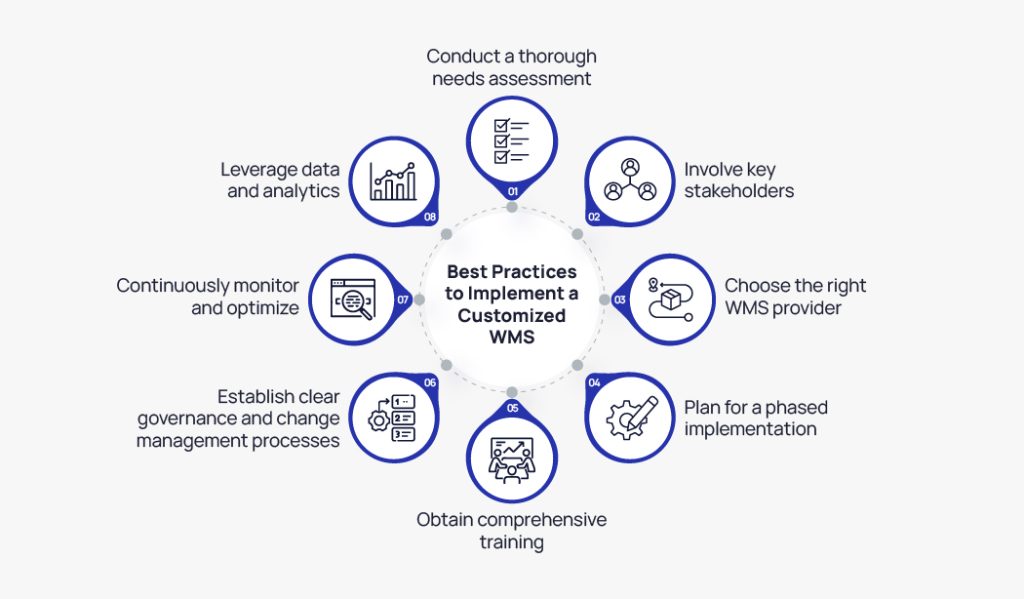Why Customization and Flexibility in Warehouse Management Systems are Crucial for Success
Blogs
Staying competitive and meeting customer demands in inventory and warehouse management is no easy feat today. The industry landscape is continuously changing and therefore demands foresight and differentiation.
When it comes to inventory and warehouse management, there are several common areas where a Warehouse Management System can assist. For example, stock take accuracy, order fulfillment, and error reduction. However, inventory and warehouse management needs can go beyond this and differ from industry to industry. Cosmetic, pharmaceutical, and FMCG products need batch and expiry management, and temperature-controlled storage to avoid spoilage.
Brands selling fashion and apparel may need kit and bundle management. Additionally. Those brands and retailers selling online will need to integrate their online sales channels to their inventory hubs or warehouses for smooth order processing and fulfillment.
So how do you as a 3PL, brand, retailer, or distributor support these different requirements? The answer is a flexible warehouse management system (WMS) that can be customized to suit specific needs and requirements.
In this blog, you’ll understand what a WMS must be capable of and how this impacts your business:
- The Role of Customization in a WMS
- Businesses that Benefited from Customization and Flexibility in a WMS
- How to Choose a WMS with Customization and Flexibility
- How to Implement a Customized WMS
- The Future of Warehouse Management Systems and the Role of Customization and Flexibility
The Role of Customization in a WMS
The global WMS market is expected to reach USD 8.6 billion by 2029 [1]. Factors like streamlining supply chain operations to enhance customer experience and the thriving e-commerce industry are driving WMS market growth. A warehouse management system is currently the backbone of modern logistics operations. It provides you with the tools and technologies to streamline warehouse activities.
That said, there are numerous WMS products to choose from today. A one-size-fits-all WMS often falls short of meeting the unique requirements of different industries and individual businesses. This is where the role of a customizable WMS becomes crucial.
Customization allows you to tailor your WMS to specific needs, address unique challenges and pain points you face with day-to-day operations. By incorporating industry-specific features and functionalities, a customized WMS can address unique challenges across various sectors. For cosmetics and personal care, it enhances shelf-life management. In the electronics industry, it ensures precise serial number tracking and component management and warranty management and security of high-value items. Perishable goods benefit from temperature control monitoring and expiration date tracking, while the pharmaceutical industry is enabled to meet stringent regulations and controlled substance management. These tailored solutions streamline operations, ensure regulatory compliance, and improve overall efficiency, making them essential for industry-specific needs.
Moreover, a customized WMS can streamline workflows, automate repetitive tasks, and optimize warehouse operations to achieve greater efficiency and productivity. This, in turn, can lead to improved customer satisfaction, reduced operational costs, and a competitive edge in the market.
Businesses that Benefited from Customization and Flexibility in a WMS
The benefits of a customized warehouse management system (WMS) are best illustrated through real-world case studies. Let’s explore how two different businesses have leveraged customization to address their unique challenges and drive operational efficiency.
Case Study 1: ERHA Pharmacy Indonesia
A leading dermatology brand, ERHA, was struggling with inventory management and product traceability in its warehouse operations. By implementing a customized WMS, the company was able to address these challenges. The customized system incorporated features like batch and expiration date monitoring, stock take accuracy, automated picking, and centralized kit and bundle management. This allowed the company to ensure its products were rotated and distributed based on shelf life, reducing the risk of expired or damaged goods reaching customers.
The enhanced traceability capabilities of the customized WMS also enabled the cosmetics manufacturer to quickly identify and isolate any problematic batches, streamlining the recall process and protecting the brand’s reputation. As a result, the company experienced a significant reduction in product waste, improved customer satisfaction, and increased operational efficiency.
Case Study 2: Asendia
When Asendia, a joint venture between the French and Swiss national postal services, wanted to transition from its legacy systems to new-age technology, it needed a solution that could fulfill all its requirements. They needed a full-suite and agile system that could accommodate their large and complex network of customers, and respond to a rapidly changing environment. As the company was operating across regions globally – Asia, Europe, and USA – managing operations on the legacy system was a major challenge.
After researching for a customizable WMS, the came across Ancahnto’s Warehouse Management System. In addition to their key warehouse management capabilities, the SaaS technology provider also offered Asendia additional customizations, like:
- New cross-border flows with faster support functions, enhanced APIs and consistent workflows to help Asendia support their customers selling on Shopee across borders.
- Enhanced integrations with webstore builders such as Shopify, Magento, WooCommerce with custom requirements.
- New customer integrations that require specific API configurations and carrier selection.
These case studies demonstrate how customization can be a game-changer for businesses, allowing them to overcome industry-specific challenges, improve operational efficiency, and gain a competitive edge in their respective markets.
How to Choose a WMS with Customization and Flexibility
When selecting a warehouse management system (WMS) that offers customization and flexibility, there are several key features to consider. These features can make a significant difference in the system’s ability to meet the unique needs of your business and adapt to changing requirements over time.
- Modular architecture: A WMS with a modular architecture allows for easy customization and scalability. This means that individual components or modules can be added, removed, or modified without disrupting the entire system, providing the flexibility to adapt to evolving business needs.
- Configurable workflows: The ability to configure workflows within the WMS is crucial. This allows businesses to align the system with their specific operational processes, streamlining activities such as receiving, put-away, picking, packing, and shipping.
- Integration capabilities: A flexible WMS should seamlessly integrate with other critical business systems, such as enterprise resource planning (ERP) software, transportation management systems (TMS), shipping carriers, and e-commerce platforms. This integration ensures a unified view of the entire supply chain and enables data-driven decision-making.
- Reporting and analytics: Robust reporting and analytics capabilities in a customized WMS can provide valuable insights into warehouse performance, inventory management, and operational efficiency. This data can inform decision-making and drive continuous improvement.
- Mobility and remote access: The ability to access the WMS from mobile devices and remotely can enhance warehouse productivity and flexibility, allowing employees to perform tasks and monitor operations from anywhere.
- Customizable user interface: A user-friendly and customizable interface can improve employee adoption and productivity, as users can personalize the system to their specific needs and preferences.
- Scalability and growth potential: As a business grows and evolves, the WMS should be able to scale up or down to accommodate changes in volume, complexity, and technological advancements. This ensures the system remains a valuable asset over the long term.
By carefully considering these key features, businesses can find a WMS that not only meets their current requirements but also provides the customization and flexibility needed to adapt to future challenges and opportunities.
How to Implement a Customized WMS
Implementing a customized warehouse management system (WMS) can be a complex and challenging process, but following best practices can help ensure a successful deployment and long-term success. Here are some key considerations:
- Conduct a thorough needs assessment: Thoroughly understand your business’s unique requirements, pain points, and operational processes. For example, integration with online sales channels like Amazon and Lazada. Or the need for product serial number and batch management. This will help you identify the specific features and functionalities needed in a customized WMS.
- Involve key stakeholders: Engage with cross-functional teams, including warehouse managers, IT professionals, and end-users, to gather input and ensure the customized WMS addresses the needs of all stakeholders.
- Choose the right WMS provider: Select a WMS vendor like Anchanto that has a proven track record of delivering customizable and flexible solutions and a deep understanding of your industry. Evaluate their technical capabilities, project management skills, and customer support.

- Plan for a phased implementation: Break down the implementation process into manageable phases, allowing for gradual adoption and minimizing disruption to your existing operations. This approach also enables you to validate the customized features and make necessary adjustments along the way.
- Obtain comprehensive training: Ensure that your employees receive thorough training on the customized WMS, including its new features and workflows. This will help drive user adoption and maximize the system’s benefits.
- Establish clear governance and change management processes: Implement robust governance structures and change management protocols to manage any future modifications or upgrades to the customized WMS. This will help maintain system integrity and minimize the risk of disruptions.
- Continuously monitor and optimize: Regularly review the performance of the customized WMS, gather feedback from users, and make adjustments as needed. This will help ensure the system remains aligned with your evolving business requirements.
- Leverage data and analytics: Utilize the reporting and analytics capabilities of the customized WMS to gain valuable insights into warehouse operations, identify areas for improvement, and make data-driven decisions.
By following these best practices, businesses can ensure a successful implementation of a customized WMS and maximize the benefits of a tailored solution that meets their unique needs.
Get the Ideal WMS for Your Needs Through Our ExpertsConclusion: The Future of Warehouse Management Systems and the Role of Customization and Flexibility
In the years to come, the ability to customize and maintain flexibility within these systems will be a key differentiator for companies seeking to stay ahead of the competition.
As the role of data and analytics continues to expand, the ability of a customized WMS to provide robust reporting and insights will become increasingly important. Businesses will rely on these data-driven capabilities to make informed decisions, optimize their warehouse operations, and drive continuous improvement.
Furthermore, the integration of emerging technologies, such as artificial intelligence, machine learning, and the Internet of Things, will shape the future of WMS. These innovations will enable greater automation, predictive capabilities, and real-time visibility, further enhancing the efficiency and responsiveness of warehouse management.
In conclusion, the future of warehouse management systems will be defined by the importance of customization and flexibility. By investing in tailored solutions that address their unique needs and maintain the agility to adapt to changing circumstances, businesses can position themselves for long-term success in the competitive world of supply chain management.
FAQs
1. What is a WMS?
A Warehouse Management System (WMS) is software that helps manage and optimize the day-to-day operations within a warehouse, including inventory tracking, order fulfillment, and storage management. It streamlines processes by providing real-time visibility and control over inventory, improving efficiency and accuracy in warehouse operations.
2. What are warehouse workflows?
Warehouse workflows are the structured processes that guide the movement and handling of goods within a warehouse, from receiving and storing inventory to picking, packing, and shipping orders. These workflows ensure that tasks are performed efficiently and accurately, often integrating with systems like WMS to automate and optimize operations, reduce errors, and improve productivity.
3. What are warehouse integrations?
Warehouse integrations involve connecting a WMS with other systems, such as ERP, e-commerce platforms, or transportation management systems, to enable seamless data flow and coordinated operations across the supply chain. These integrations enhance efficiency by automating tasks like order processing, inventory updates, and shipping, ensuring that all systems work together to support real-time decision-making and streamline warehouse operations.
References –
